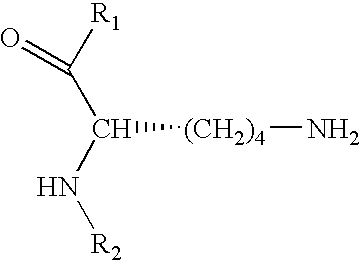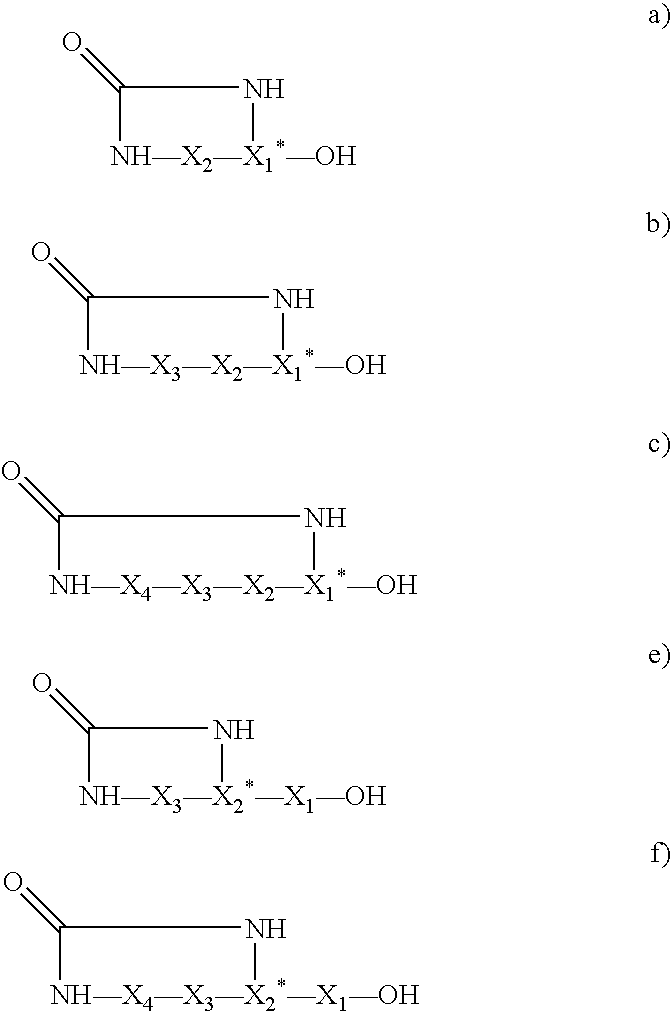Affinity screening using "one-bead-one-compound" libraries
- Summary
- Abstract
- Description
- Claims
- Application Information
AI Technical Summary
Benefits of technology
Problems solved by technology
Method used
Image
Examples
example 1
Synthesis of N-(N′-Fmoc-13-amino-4,7,10-trioxa-tridecyl)-succinamic acid (2)
[0263] N-N′-Fmoc-13-amino4,7,10-trioxa-tridecyl)-succinamic acid (2), shown above in Table 1, was prepared as shown in Scheme 5.
[0264] 4,7,10-Trioxa-1,13-tridecanediamine (5 g, 22.7 mmol, 5 mL) was dissolved in a solution of Na2CO3 (7 g) in H2O (50 mL). Succinic anhydride (2.5 g, 2.5 mmol) in dioxane (50 mL) was added dropwise. The solution turned misty, then into a suspension. It was stirred at room temperature for 24 hours, then heated at 80° C. for another 1 hour. Solvent was removed under vacuum. The residue was treated with 1 N NaOH (200 mL) and extracted with DCM (2×100 mL). The aqueous phase was separated, acidified to pH 1 with 1 N HCl, extracted with DCM (2'100 mL), then neutralized with NaHCO3 to pH 7.
[0265] The crude material was dissolved in 50% acetone / H2O (120 mL) and Na2CO3 (5 g) was added. Fmoc-OSu (7.5 g, 22.3 mmol) was added in portions over 1 hour while pH was kept between 9-10 by addit...
example 2
Synthesis of (2S,4S)-Nα-Fmoc-4-N,N′-di-Boc-guanidinoproline (25a) and (2S,4S)-Nα-Boc-4-N,N′-di-Boc-guanidinoproline (25b)
[0267] (2S,4S)-Nα-Fmoc-4-N,N′-di-Boc-guanidinoproline (25a) and (2S,4S)-Nα-Boc-4-N,N′-di-Boc-guanidinoproline (25b) shown above in Table 2, were prepared from Z-Hyp-OH according to literature procedure described in Tamaki et al., 2001, J. Org. Chem. 66: 1038-1042), as shown in Scheme 6.
example 3
Synthesis of Fmoc-Dapa(Pal)-OH (30a)
[0268] Fmoc-Dapa (PAL)-OH (30a) as shown above in Table 2, was prepared as shown in Scheme 7.
[0269] Fmoc-Dapa-OH (500 mg, 1.53 mmol) and diisopropylethylamine (780 mg, 6 mmol, 1 mL) were dissolved in DCM (20 nL). Pabmitoyl chloride (420 mg, 1.53 mmol, 0.46 mL) was added drop-wise with stirring using a syringe. The suspension slowly became clear. After stirring at room temperature for 2 hours, the solution was concentrated under vacuum. The residue was purified by flash chromatography with DCM:EtOH (10:1) to give pure product (800 mg, 98%) as white powder:
[0270]1H NMR (CDCl3, δ) 7.68 (m, 211), 7.49 (m, 2H), 7.19-7.33 (m, 411), 4.27 (br, 2H), 4.01 (m, 1H), 3.62 (br, 1H), 2.10 (br, 2H), 1.44 (br, 2H), 1.17 (m, 28H), 0.8 (m, 3H), 13C NMR (CDCl3, δ ) 176.4, 157.1, 144.1, 143.9, 141.7, 141.6, 128.1, 127.5, 126.2, 125.5, 120.4, 67.7, 47.5, 42.3, 36.7, 32.3, 30.1, 30.0, 29.9, 29.8, 29.6, 23.1, 14.5.
PUM
| Property | Measurement | Unit |
|---|---|---|
| Current | aaaaa | aaaaa |
| Size | aaaaa | aaaaa |
Abstract
Description
Claims
Application Information
 Login to View More
Login to View More - R&D
- Intellectual Property
- Life Sciences
- Materials
- Tech Scout
- Unparalleled Data Quality
- Higher Quality Content
- 60% Fewer Hallucinations
Browse by: Latest US Patents, China's latest patents, Technical Efficacy Thesaurus, Application Domain, Technology Topic, Popular Technical Reports.
© 2025 PatSnap. All rights reserved.Legal|Privacy policy|Modern Slavery Act Transparency Statement|Sitemap|About US| Contact US: help@patsnap.com



